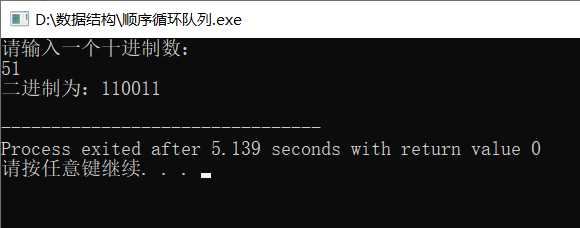标签:return 进入 遍历 maxsize empty lse 存储 mic 出队
循环队列的基本操作:
1 #include<stdio.h> 2 #include<stdlib.h> 3 #define maxSize 20 4 typedef int QElemType; 5 typedef struct 6 { 7 QElemType elem[maxSize]; 8 int front,rear; 9 }CircQueue; 10 void InitQueue(CircQueue *Q) //初始化队列 11 { 12 Q->front=Q->rear=0; 13 } 14 int EnQueue(CircQueue *Q,QElemType x) //进队列 15 { 16 if((Q->rear+1)%maxSize==Q->front) 17 { 18 return 0; 19 } 20 Q->elem[Q->rear]=x; 21 Q->rear=(Q->rear+1)%maxSize; 22 return 1; 23 } 24 int DeQueue(CircQueue *Q,QElemType *x) //出队列 25 { 26 if(Q->front==Q->rear) 27 { 28 return 0; 29 } 30 *x=Q->elem[Q->front]; 31 Q->front=(Q->front+1)%maxSize; 32 return 1; 33 } 34 int QueueSize(CircQueue *Q) //求对列长度 35 { 36 return (Q->rear-Q->front+maxSize)%maxSize; 37 } 38 int QueueEmpty(CircQueue *Q) //判断队列空否 39 { 40 return Q->front==Q->rear; 41 } 42 int QueueFull(CircQueue *Q) //判断队列满否 43 { 44 return (Q->rear+1)%maxSize==Q->front; 45 } 46 int GetFront(CircQueue *Q,QElemType *x) //读取队头 47 { 48 if(Q->front==Q->rear) 49 { 50 return 0; 51 } 52 *x=Q->elem[Q->front]; 53 return 1; 54 }
1.返回循环队列中最小元素的值的位置:
1 int FindMin(CircQueue *Q) 2 { 3 int locate=-1; //locate为最小元素的位置,物理位置 4 int x,n=QueueSize(Q); 5 int min; 6 GetFront(Q,&min); 7 for(int i=0;i<n;i++) //遍历队列 8 { 9 DeQueue(Q,&x); 10 if(min>x) 11 { 12 min=x; 13 locate=i; 14 } 15 EnQueue(Q,x); 16 } 17 return locate; 18 }
2.借助空栈将循环队列元素逆置
所需顺序栈的基本操作:
1 typedef int SElemType; 2 typedef struct 3 { 4 SElemType *elem; 5 int maxsize,top; 6 }SeqStack; 7 void StackInit(SeqStack *S) //初始化栈 8 { 9 (*S).elem=(SElemType *)malloc(maxSize*sizeof(SElemType)); 10 if(S->elem==NULL) 11 { 12 printf("存储分配错误!\n"); 13 exit(1); 14 } 15 S->maxsize=maxSize; 16 S->top=-1; 17 } 18 int StackPush(SeqStack *S,SElemType x) //进栈 19 { 20 if(S->top==S->maxsize-1) 21 { 22 return 0; 23 } 24 S->elem[++S->top]=x; 25 return 1; 26 } 27 int StackPop(SeqStack *S,SElemType *x) //出栈 28 { 29 if(S->top==-1) 30 { 31 return 0; 32 } 33 *x=S->elem[S->top--]; 34 return 1; 35 }
队列逆置:
1 void QueueReverse(CircQueue *Q) 2 { 3 int x,n=QueueSize(Q); 4 SeqStack S; 5 StackInit(&S); 6 for(int i=0;i<n;i++) 7 { 8 DeQueue(Q,&x); 9 StackPush(&S,x); 10 } 11 for(int i=0;i<n;i++) 12 { 13 StackPop(&S,&x); 14 EnQueue(Q,x); 15 } 16 }
3.使用两队列模拟栈
1 void QStackInit(CircQueue *Q1,CircQueue *Q2) //初始化模拟栈 2 { 3 InitQueue(Q1); 4 InitQueue(Q2); 5 } 6 bool QStackEmpty(CircQueue *Q1,CircQueue *Q2) //判断模拟栈空否 7 { 8 return QueueEmpty(Q1)&&QueueEmpty(Q2); 9 } 10 bool QStackFull(CircQueue *Q1,CircQueue *Q2) //判断模拟栈满否 11 { 12 return QueueFull(Q1)||QueueFull(Q2); 13 } 14 bool QStackPush(CircQueue *Q1,CircQueue *Q2,int x) //进入模拟栈 15 { 16 if(QStackFull(Q1,Q2)) 17 { 18 return false; 19 } 20 if(QStackEmpty(Q1,Q2)) 21 { 22 EnQueue(Q1,x); 23 } 24 else if(!QueueEmpty(Q1)) 25 { 26 EnQueue(Q1,x); 27 } 28 else 29 { 30 EnQueue(Q2,x); 31 } 32 return true; 33 } 34 bool QStackPop(CircQueue *Q1,CircQueue *Q2,int *x) //出模拟栈 35 { 36 if(QStackEmpty(Q1,Q2)) 37 { 38 return false; 39 } 40 if(!QueueEmpty(Q1)) 41 { 42 while(1) 43 { 44 DeQueue(Q1,x); 45 if(!QueueEmpty(Q1)) 46 { 47 EnQueue(Q2,*x); 48 } 49 else 50 { 51 break; 52 } 53 } 54 } 55 else 56 { 57 while(1) 58 { 59 DeQueue(Q2,x); 60 if(!QueueEmpty(Q2)) 61 { 62 EnQueue(Q1,*x); 63 } 64 else 65 { 66 break; 67 } 68 } 69 } 70 return true; 71 }
以下是使用模拟栈将十进制数转化二进制数:
1 int main() 2 { 3 CircQueue Q1,Q2; 4 InitQStack(&Q1,&Q2); 5 int x,i,result=0; 6 printf("请输入一个十进制数:\n"); 7 scanf("%d",&x); 8 while(x!=0) 9 { 10 i=x%2; 11 x=x/2; 12 QStackPush(&Q1,&Q2,i); 13 } 14 while(!QStackEmpty(&Q1,&Q2)) 15 { 16 QStackPop(&Q1,&Q2,&i); 17 result=result*10+i; 18 } 19 printf("二进制为:%d\n",result); 20 21 }
运行结果如下:

标签:return 进入 遍历 maxsize empty lse 存储 mic 出队
原文地址:https://www.cnblogs.com/duwenze/p/10793571.html